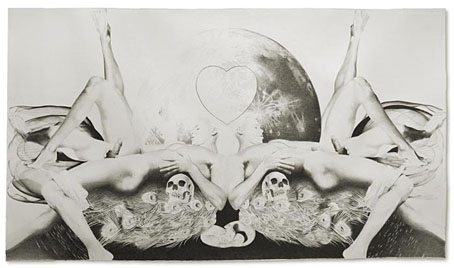I’ll be Your Mirror (2005).
Not quite finished with the Moon since it’s visible in the background of Juliet Jacobson’s beautiful drawing, together with some other items of recurrent {feuilleton} concern: masturbating males, peacock feathers and human skulls. Pam at Phantasmaphile has a larger copy of this work while Ms Jacobson’s site has a number of equally luscious pencil drawings.


Really intriguing stuff, I love this kind of visionary symbolist style. It’s a pity the images on her website aren’t larger. However, I don’t think she’s well served by the obligatory art-speak bullshit of her ‘artistic statement’… “Bilocation of Limerent Objects” ??? Still, it would be great to see some – or a lot – more of her work.
Artist statements are a scourge of the contemporary art world. As far as I can tell they became a trend after the first art market boom in the 1980s. “Market” is the crucial word here. The artist statement in the art market serves a dual function; on the one hand it gives the gallery owner a means of explaining to the would-be purchaser what the work in question is “really” about (ie: other than looking beautiful or interesting); on the other, it confirms for the purchaser that they’ve made an intelligent choice when parting with a large sum of money. No one wants to show friends a new and expensive purchase and have to say “I’ve no idea what the artist was intending with this”. Same with the gallery owners, they wouldn’t sell very much if they professed themselves clueless as to the intentions of artists.
When you read these statements the same phrases recur, so much so that they quickly become meaningless. Artists never say “I did this because I felt like it” or “I made this because it looks good”; the works are always “questioning” something or “foregrounding” an issue. People throw around words such as “liminal” and “interstitial” without ever qualifying their use, what George Orwell called “pretentious diction” in his essay Politics and the English Language, a means of giving a weak or unconvincing argument some spurious gravitas.
I feel sorry for young artists who feel the need to do this, it probably starts at art school with tutors forcing them to apply words to what should be a visual, not a verbal medium. But that’s the world in which they’re trying to work; if they didn’t it would probably affect their sales. And no one dare call bullshit on the whole business for fear of appearing philistine.
So yeah, “Bilocation of Limerent Objects”. Or “Mirrored drawings of pretty boys”… Which sounds more honest?